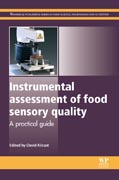
Instrumental Assessment of Food Sensory Quality: A Practical Guide
Kilcast, David
Instrumental measurements of the sensory quality of food and drink are of growing importance in both complementing data provided by sensory panels and in providing valuable data in situations in which the use of human subjects is not feasible. Instrumental assessment of food sensory quality reviews the range and use of instrumental methods for measuring sensory quality.After an introductory chapter, part one goes on to explore the principles and practice of the assessment and analysis of food appearance, flavour, texture and viscosity. Part two reviews advances in methods for instrumental assessment of food sensory quality and includes chapters on food colour measurement using computer vision, gas chromatography-olfactometry (GC-O), electronic noses and tongues for in vivo food flavour measurement, and non-destructive methods for food texture assessment. Further chapters highlight in-mouth measurement of food quality and emerging flavour analysis methods for food authentication. Finally, chapters in part three focus on the instrumental assessment of the sensory quality of particular foods and beverages including meat, poultry and fish, baked goods, dry crisp products, dairy products, and fruit and vegetables. The instrumental assessment of the sensory quality of wine, beer, and juices is also discussed.Instrumental assessment of food sensory quality is a comprehensive technical resource for quality managers and research and development personnel in the food industry and researchers in academia interested in instrumental food quality measurement. Reviews the range and use of instrumental methods for measuring sensory qualityExplores the principles and practice of the assessment and analysis of food appearance, flavour, texture and viscosityReviews advances in methods for instrumental assessment of food sensory quality INDICE: Measurement of the sensory quality of food: An introduction. Part 1 Principles and practice: Food appearance quality assessment and specification; Principles of food flavour analysis; Principles of solid food texture analysis; Principles of food viscosity analysis. Part 2 Advances in methods for instrumental assessment of food sensory quality: Food colour measurement using computer vision; Gas chromatography-olfactometry (GC-O), electronic noses and tongues for in vivo food flavour measurement; Non-destructive methods for food texture assessment; In-mouth measurement of food quality; Emerging flavour analysis methods for food authentication; Advances in analysis of instrumental food sensory quality data. Part 3 Instrumental assessment of the sensory quality of particular foods and beverages: Instrumental assessment of the sensory quality of meat, poultry and fish; Instrumental assessment of the sensory quality of baked goods; Measurement of the texture of dry crisp products; Instrumental assessment of the sensory quality of dairy products; Instrumental assessment of the sensory quality of fruit and vegetables; Instrumental assessment of the sensory quality of wine; Instrumental assessment of the sensory quality of beer; Instrumental assessment of the sensory quality of juices.
- ISBN: 978-0-85709-439-1
- Editorial: Woodhead Publishing
- Encuadernacion: Cartoné
- Páginas: 656
- Fecha Publicación: 07/10/2013
- Nº Volúmenes: 1
- Idioma: Inglés
